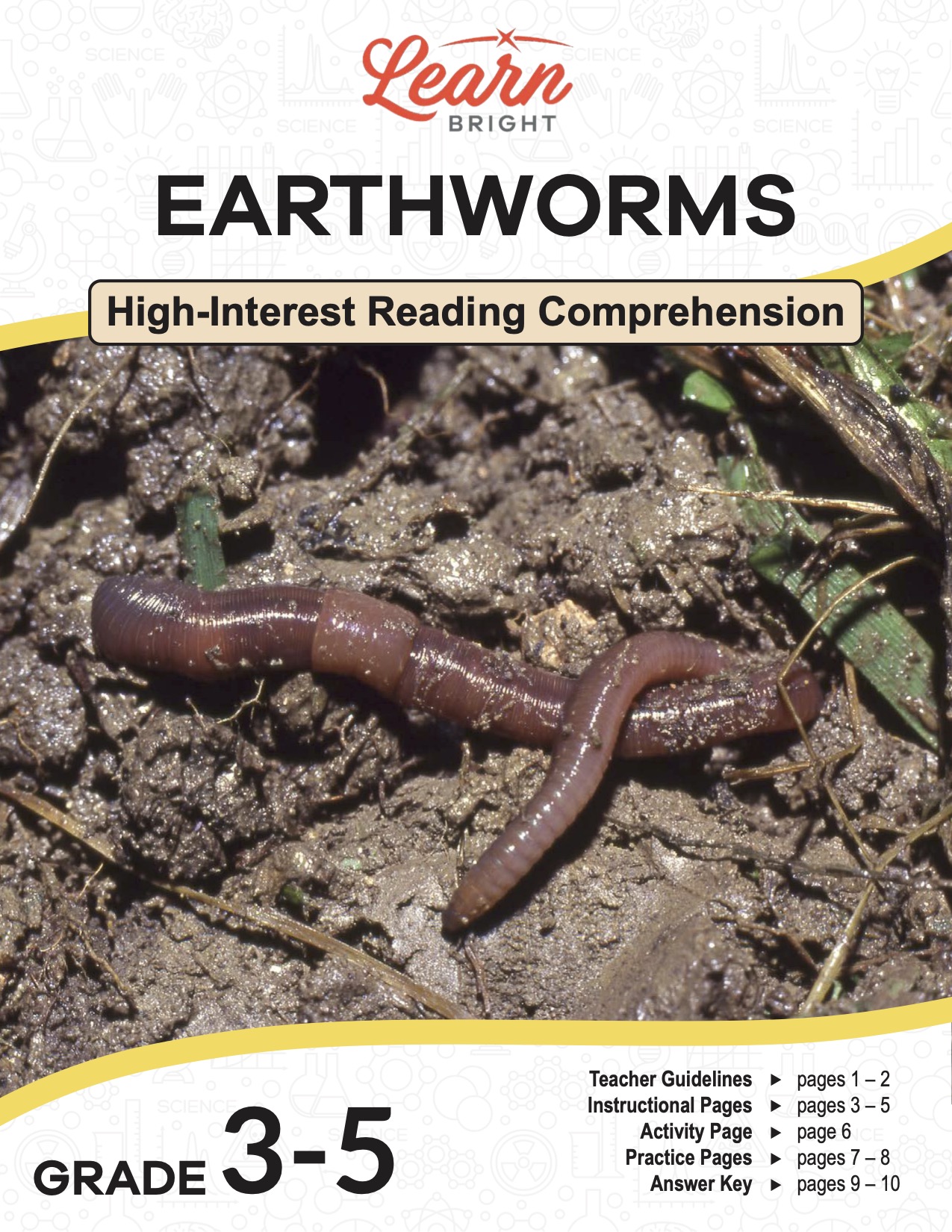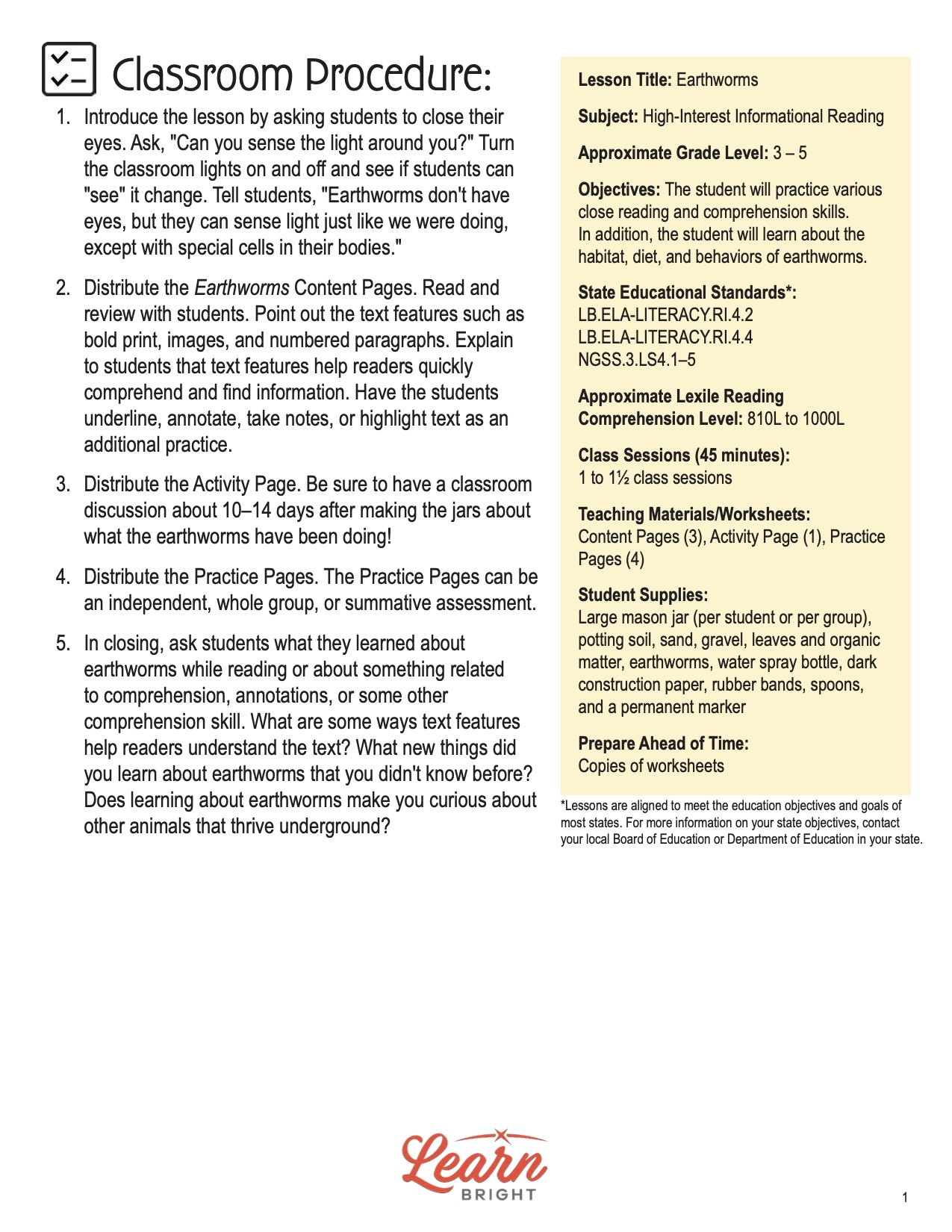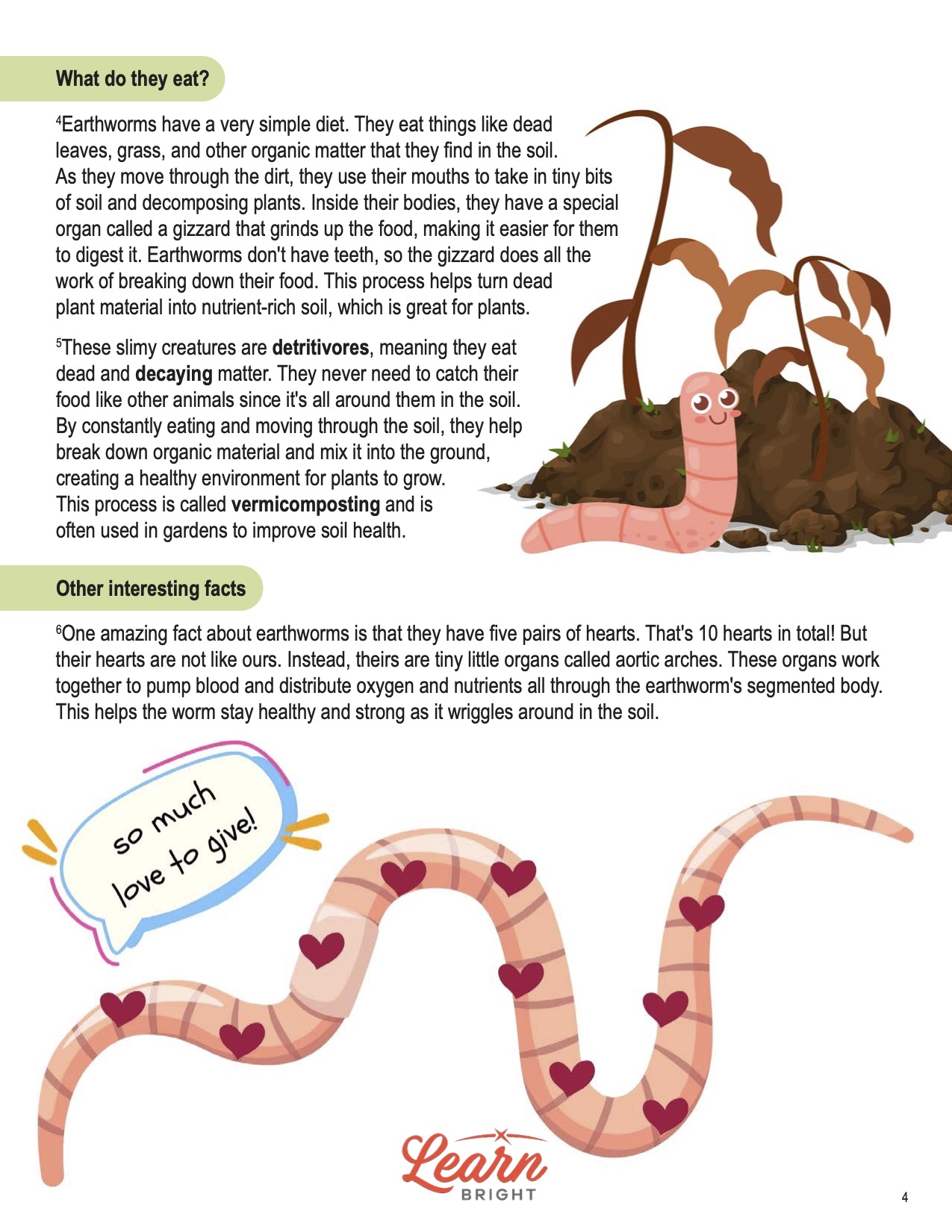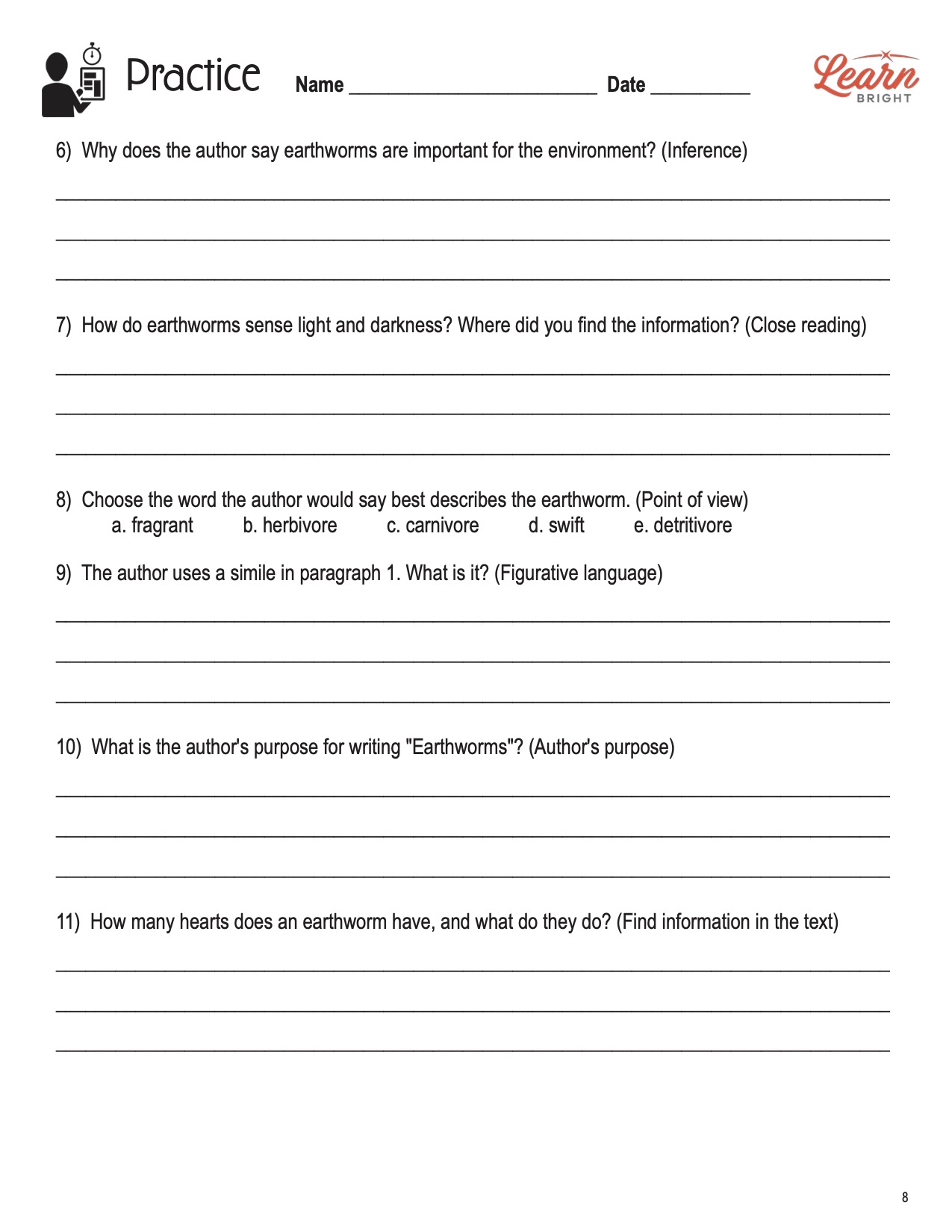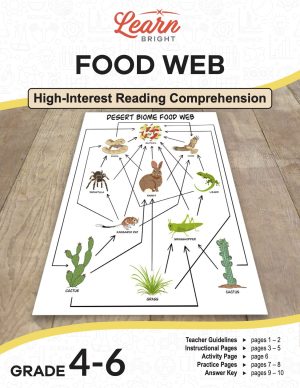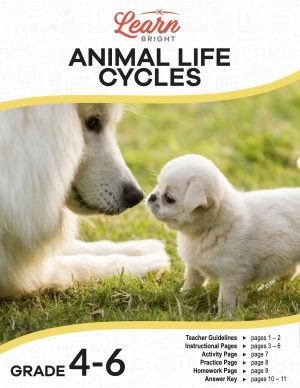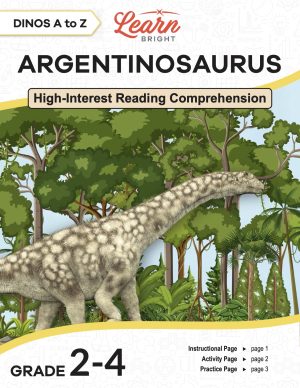Description
What our Earthworms lesson plan includes
Lesson Objectives and Overview: Earthworms is a high-interest reading comprehension lesson plan. As such, students will practice various close reading and comprehension skills. In addition, they will learn about the habitat, diet, and behaviors of earthworms. This lesson is for students in 3rd grade, 4th grade, and 5th grade.
Classroom Procedure
Every lesson plan provides you with a classroom procedure page that outlines a step-by-step guide to follow. You do not have to follow the guide exactly. The guide helps you organize the lesson and details when to hand out worksheets. It also lists information in the yellow box that you might find useful. You will find the lesson objectives, state standards, and number of class sessions the lesson should take to complete in this area. In addition, it describes the supplies you will need as well as what and how you need to prepare beforehand.
Teacher Notes
The teacher notes page provides an extra paragraph of information to help guide the lesson and remind you what to focus on. It explains that you can teach this lesson in a whole-class setting or as an independent, small-group activity. The blank lines on this page are available for you to write out thoughts and ideas you have as you prepare the lesson.
EARTHWORMS LESSON PLAN CONTENT PAGES
What Is an Earthworm?
The Earthworms lesson plan contains three content pages. To start off, it provides a small box with basic background information about these slimy critters. They are invertebrates that live everywhere except for the cold regions of Antarctica and the Arctic. They live off of decaying organic waste and only live between one and two years.
Earthworms are small, tube-shaped animals that live in the ground. They have long, soft bodies that are made up of many segments which look like little rings. Each segment has tiny bristles called setae that help the earthworm move through the soil. Earthworms don’t have eyes, but they can sense light and darkness with special cells in their skin. Their mouths are located at the front end, and they use them to eat dirt and organic matter, which helps them get nutrients.
Generally, earthworms live in moist, dark places like soil, leaf litter, and compost piles. They need moisture to breathe because they absorb oxygen through their skin by the process of diffusion. During this process, oxygen and carbon dioxide dissolve in the moisture and then diffuse through the skin. So, if the soil is too dry, the worms could die. Earthworms often come to the surface after it rains because the wet ground makes it easier for them to move around. They are very important for the soil because they create tunnels as they move, which helps air and water reach plant roots.
Sometimes you can find many earthworms together in the same area if there is a lot of food, but they are mostly solitary creatures. They reproduce by joining their bodies together and exchanging sperm. After this, they each lay eggs in a cocoon. The eggs hatch into tiny baby earthworms. Earthworms do not take care of their babies after they are born. Instead, the young worms have to survive by finding food and shelter on their own.
What Earthworms Eat
Earthworms have a very simple diet. They eat things like dead leaves, grass, and other organic matter that they find in the soil. As they move through the dirt, they use their mouths to take in tiny bits of soil and decomposing plants. Inside their bodies, they have a special organ called a gizzard that grinds up the food, making it easier for them to digest it. Earthworms don’t have teeth, so the gizzard does all the work of breaking down their food. This process helps turn dead plant material into nutrient-rich soil, which is great for plants.
These slimy creatures are detritivores, meaning they eat dead and decaying matter. They never need to catch their food like other animals since it’s all around them in the soil. By constantly eating and moving through the soil, they help break down organic material and mix it into the ground, creating a healthy environment for plants to grow. This process is called vermicomposting and is often used in gardens to improve soil health.
Fun Facts about Earthworms
One amazing fact about earthworms is that they have five pairs of hearts. That’s 10 hearts in total! But their hearts are not like ours. Instead, theirs are tiny little organs called aortic arches. These organs work together to pump blood and distribute oxygen and nutrients all through the earthworm’s segmented body. This helps the worm stay healthy and strong as it wriggles around in the soil.
Earthworms can regenerate parts of their bodies. If an earthworm is cut in half, sometimes the head part (the side closest to the band) can grow a new tail. However, the tail part can’t grow a new head. This ability to regenerate helps them survive if they get injured.
Another strange fact is that earthworms don’t have eyes. Instead, they can sense light and vibrations through their skin. They prefer to stay underground during the day to avoid sunlight and predators. They are also very strong for their size. In fact, they can push through soil that is much heavier than they are, thanks to their muscular bodies and tiny bristles called setae. These setae help them grip the soil and move forward.
Why They Are Important
Earthworms are very important for the environment because they help keep the soil healthy. Their tunnels allow air and water to reach plant roots, which helps plants grow strong. Earthworms also eat dead leaves and other organic material, breaking it down into smaller pieces. This process turns the material into nutrient-rich soil, which provides essential nutrients for plants. Without earthworms, the soil would not be as fertile, and it would be harder for plants to grow.
Earthworms are not currently endangered, but they do face some threats. Pesticides and chemicals used in farming can harm earthworms and reduce their numbers. Pollution and habitat destruction can also affect them. It’s important to protect earthworms by using fewer chemicals in gardens and farms and by keeping the environment clean. By taking care of the places where earthworms live, we can help them
continue to thrive and do their important work in the soil.
EARTHWORMS LESSON PLAN WORKSHEETS
The Earthworms lesson plan includes two worksheets: an activity worksheet and a practice worksheet. Each one will help students solidify their grasp of the material they learned throughout the lesson. You can refer to the classroom procedure guidelines to know when to hand out each worksheet.
EARTHWORM JARS ACTIVITY WORKSHEET
For the activity, students will create an earthworm jar to observe for a few weeks. They will use the supplies you provide and follow the steps on the activity page to complete the assignment. The last step is to have a discussion about what they learned during the activity. There are three questions for students to answer and discuss.
REVIEW PRACTICE WORKSHEET
The practice worksheet requires students to answer a series of 11 questions. These questions all relate to the content pages, so students will need to refer to them often for the answers. In addition, each question provides which reading tool the question corresponds to, such as text feature, vocabulary, or comprehension.
Worksheet Answer Keys
At the end of the lesson plan document is an answer key for the practice worksheet. The correct answers are all in red to make it easier for you to compare them with students’ responses. If you choose to administer the lesson pages to your students via PDF, you will need to save a new file that omits these pages. Otherwise, you can simply print out the applicable pages and keep these as reference for yourself when grading assignments.

